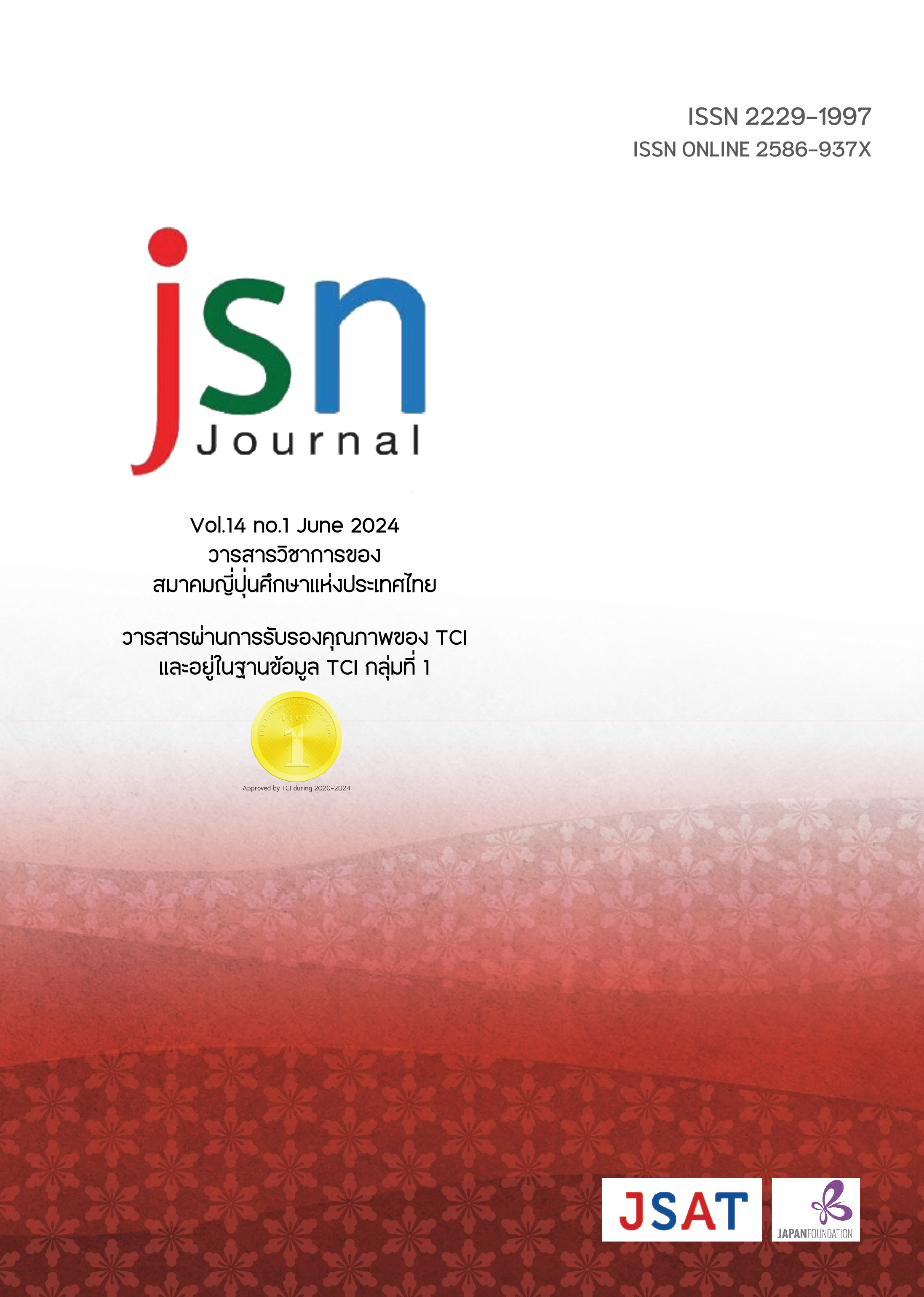Reading Strategy Use of Thai JFL College Students With Different Reading Ability
Main Article Content
Abstract
This research aims 1) to investigate the reading strategy use of Thai JFL college students; 2) to study the reading strategy use at different levels of Japanese reading ability; and 3) to study the relationship between reading strategies and Japanese reading ability. The sample group used in this research was 200 students majoring in Japanese (2nd year, 3rd year, and 4th year) from two universities in Thailand. The research tools were a questionnaire on reading strategies,a reading comprehension test, and an interview (think-alound) from a sample of 20 students. The results of the research revealed that 1) the most-used Japanese reading strategy was problem solving, followed by support strategies and global strategies; 2) the group of learners with a high level of reading ability used reading strategies more than those with a low level of reading ability; 3) the relationship between global reading strategies and reading ability (reading test score) was found among the learners that had a high level of reading ability in Japanese. However, there was no relationship among the learners with a low level of reading ability. The results of this research will benefit the teaching of Japanese reading; they will help teachers understand more about students' reading strategies and be able to apply them to activities to help promote reading skills so that students can succeed in their reading.
Article Details

This work is licensed under a Creative Commons Attribution-NonCommercial-NoDerivatives 4.0 International License.
ข้อความและข้อคิดเห็นต่างๆ ในบทความเป็นของผู้เขียนบทความนั้นๆ ไม่ใช่ความเห็นของกองบรรณาธิการหรือของวารสาร jsn Journal
References
เตวิช เสวตไอยาราม. (2559). กลยุทธ์การอ่านของผู้เรียนภาษาญี่ปุ่นชาวไทยที่มีความสามารถต่างกัน. วารสารญี่ปุ่นศึกษา, 33(2), 59-78.
ฉัตรณรงค์ ชัยเดช. (2562). กลวิธีการอ่านภาษาอังกฤษของผู้เรียนที่ใช้ภาษาอังกฤษในฐานะภาษาต่างประเทศ : กรณีศึกษาของผู้เรียนที่มีความรู้พหุระดับ.รายงานการวิจัย. มหาวิทยาลัยราชภัฏมหาสารคาม
พรพิมล ศุขะวาที. (2560). การใช้กลยุทธ์การอ่านเพื่อพัฒนาทักษะการอ่านภาษาอังกฤษเชิงวิจารณ์โดยผ่านการเรียนแบบผสมผสานของนิสิตครุศาสตร์เอกภาษาอังกฤษ.วารสารครุศาสตร์, 45(2), 72-89.
อดิศรา กาติ๊บ. (2540). เทคนิค TOL (Think-aloud). วารสารภาษาปริทัศน์, 16, 50–59. สืบค้นจาก https://www.culi.chula.ac.th/Images/asset/pasaa_paritat_journal/file-15-269-6hy9cs183525.pdf
Afflerbach, P., Pearson, D. P. & Paris, S. G. (2008). Clarifying Differences Between Reading Skills and Reading Strategies. The Reading Teacher. (pp. 364-373).
Afflerbach, P., & Cho, B.Y. (2009). Identifying and describing constructively responsive comprehension strategies in new and traditional forms of reading. In S.E. Israel & G.G. Duffy (Eds.), Handbook of research on reading comprehension (pp. 69–90). New York: Routledge.
Akkakoson, S. & Setobol, B. (2009). Thai EFL Students’Use of Strategies in Reading English Texts.The Journal of KMUTNB, 19(3), 329-342.
Barnard, R., Brookes, H., Pozzo, G., & Rowe, T. (1980). Reading Strategies. In G. Cortese (Ed.), Reading in a Foreign Language (pp. 400-415). Milan: Franco Angeli.
Barnett, M. A. (1988). Reading through context: How real and perceived strategy use affects L2 comprehension. Modern Language Journal, 72, 150-160.
Block, E. (1986). The comprehension strategies of second language readers. TESOL Quarterly, 20, 463-494.
Jaengsaengthong Wipasiri. (2015). Metacognitive Reading Strategies Used by Thai EFL University Students. Journal of Graduate Studies in Northern Rajabhat University, 11, 1-14.
Karbalaei, A. (2010). A comparison of the metacognitive reading strategies used by EFL and ESL readers. The Reading Matrix, 10(2), 165-180.
Meniado, J. (2016). Metacognitive reading strategies, motivation, and reading, comprehension performance of Saudi EFL students. English Language Teaching, 9(3), 117-129.
Mokhtari, K., & Sheorey, R. (2002). Measuring ESL students' awareness of reading strategies. Journal of Developmental Education, 25(3), 2-10.
Nielsen, J., & Yssing, C. (2004). What Kind of Information Does an HCI Expert Want? — On Concurrent Usability Testing. Retrieved December 1, 2023, from https://www.researchgate.net/publication/ 5094186_What_Kind_of_Information_does_an_HCI_expert_want
Oxford, R. L. (1990). Language learning strategies: what every teacher should know. Boston: Heinle & Heinle Publishers.
Park, Y.H. (2010). Korean EFL College Students’ Reading Strategy Use to Comprehend Authentic Expository/Technical Texts in English. Published Doctoral Dissertation, University of Kansas.
Phakiti, Aek. (2003). A Closer Look at the Relationship of Cognitive and Metacognitive Strategy Use to EFL Reading Achievement Test Performance. Language Testing, 20(1), 26-56.
Oranpattanachai Pornpun ( 2010). PERCEIVED READING STRATEGIES USED BY THAI PRE-ENGINEERING STUDENTS. ABAC Journal, 30(2), 26-42.
Zhang, L. J., & Wu, A. (2009). Chinese Senior High School EFL Students' Metacognitive Awareness and Reading-Strategy Use. Reading in a Foreign Language, 21(1), 37- 59.
櫻井直子(2019).「第二言語としての日本語の読解―低次レベレ処理に焦点を当てて―」『日本大学大学院総合社会情報研究科紀要』20, 273-284.
高橋亜紀子(1998).「中級日本語学習者の読解ストラテジー : 韓国人学習者の場合」『東北大学文学部日本語学科言語科学論集』2, 89-96.
橋口美紀(2002).「大学生の読解ストラテジーに対する認識と読解能力との関係 について」『鹿屋体育大学学術研究紀要』27, 29-41.
南之園博美(1997).「読解ストラテジーの使用と読解力との関係に関する研究—外国語としての日本語テキスト読解の場合—」『世界の日本語教育』7, 31-44.


